What is it ichthyosis?
Ichthyosis is a disorder of cornification, characterized by persistently dry, thickened, 'fish scale'skin. There are at least 20 varieties of ichthyosis, including both inherited and acquired forms.
Who gets ichthyosis?
Inherited forms of ichthyosis
Inherited types of ichthyosis can be congenital or has delayed the appearance.
-
Ichthyosis vulgaris (1: 250-1000) has a autosomal dominant inheritance, which means an abnormal gene It is inherited from a parent. Penetration en 90% Onset is delayed until at least three months of age.
-
Recessive ichthyosis linked to the X chromosome (1: 2000-6000) mainly affects males, who have only one X chromosome with the abnormal gene Females are protected by having a second normal X chromosome. Onset can be congenital or delayed for up to 6 months.
- In autosomal recessive congenital ichthyosis (1: 3–500,000) an abnormal gene is inherited from each parent.
- Keratinopathic ichthyosis (1: 200,000) have recessive and dominant forms and present at birth with a collodion membrane.
Ichthyosis can also be due to a new spontaneous mutation.
Acquired ichthyosis
Acquired ichthyosis appears in adult life. People with ichthyosis may have a systemic disease, such as:
- Hodgkin lymphoma
- Underactive thyroid
- Sarcoidosis
- Cancer (ichthyosis can be a cutaneous inmate marker malignancy)
- HIV infection
Ichthyosis can be caused by certain medications:
- Nicotinic acid
- Kava
- Targeted cancer therapy (eg, Vemurafenib, EGFR, and protein kinase inhibitors)
-
Hydroxyurea
What Causes Ichthyosis?
Inherited forms of ichthyosis occur as a result of genetic mutations that alter the appearance and behavior of keratinocytes (skin cells) in the stratum corneum (the outer skin barrier layer). Studies have shown that there are inflammatory cells and cytokines in the Th17 pathway that contribute to symptoms and signs.
The cause of acquired ichthyosis is unknown.
How are hereditary ichthyosis classified?
The names and classification of ichthyosis are evolving with a greater understanding of the molecular causes of diseases [1]. The mutated genes are shown in italics.
Common ichthyosis
Common ichthyosis are:
-
Ichthyosis vulgaris (95% of all ichthyosis cases) FLG (filaggrin is a structural protein)
-
X-linked recessive ichthyosis STS
Autosomal recessive congenital ichthyosis
-
Harlequin Ichthyosis ABCA12
- Lamellar ichthyosis TGM1 (transglutaminase 1 is a enzyme) and others
- Congenital ichthyosiform erythroderma ALOXE3 and others
Keratinopathic ichthyosis
This group has curb mutations The main types of keratinopathic ichthyosis are:
- Epidermolytic ichthyosis * KRT1, KRT10
- Superficial epidermolytic ichthyosis KRT2
- Curth-Macklin§ ichthyosis KRT1
- Congenital lattice Ichthyosiform erythroderma
* Formerly called epidermolytic hyperkeratosis or bullous Ichthyosiform erythroderma
¶ Formerly called Siemens bullous ichthyosis
§ Formerly called ichthyosis hystrix
There are many other rare types of ichthyosis with definite genetic abnormalities and clinical features.
What are the clinical features of ichthyosis?
Ichthyosis varies in appearance and severity depending on the cause and effect of the gene modification.
Ichthyosis vulgaris
- The skin may appear normal at birth.
- By the age of 5, the skin is dry with fine white scales
- Affects abdomen, arms and legs, saving folds of arms and legs.
- Causes keratosis pilaris
- The palms are excessively lined.
- Associate with atopic eczema in 50%
X-linked recessive ichthyosis
- Generalized fine or rhomboid gray / brown scale is present at or within six months of birth
- Climbing It is most prominent on the extremities, neck, trunk and buttocks
- Palms are normal
- Corneal opacities in 50%
- It only affects men
- Undescended testes at 5–20%
Autosomal recessive congenital ichthyosis-1 (ARCI1)
- The baby is covered by a collodion membrane at birth, which cracks and then falls off; 10% heals itself
-
Harlequin ichthyosis: severe collodion membrane, ectropion (drooping of the lower eyelids), eclabium (crooked lips) and contractures
- Lamellar ichthyosis - dark, plate-like scales over the entire body, including folds of arms and legs
- Swimsuit variant: located to the scalp and trunk (warmest places on the body)
- Non-bullous congenital ichthyosiform erythroderma (NCIE): erythroderma and fine, white, superficial and semi-adherent scales
- Palmoplantar keratoderma varies with the affected gene
Keratinopathic ichthyosis
- The skin is moist, red, and sensitive at birth.
- Fluid-filled blisters can develop that can become infected and lead to a bad odor on the skin.
- The thick, widespread white to brown scales occur within a few weeks, especially during extensor muscle joints
- Epidermolytic ichthyosis can cause slow spread cancel polycyclic erythematous plates
- Porcupine or pointy appearance in Curth-Macklin ichthyosis, due to varied scale thickness
- KT-1 the mutation causes palmoplantar keratoderma (KRT-10 no)
- Growth failure may occur
- The mosaic shape causes epidermal nevus
Acquired ichthyosis
- It resembles ichthyosis vulgaris but develops in adult life
- You may have an underlying disease.
- The patient may be taking a drug that is known to cause dry skin
Ichthyosis
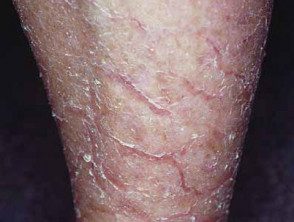
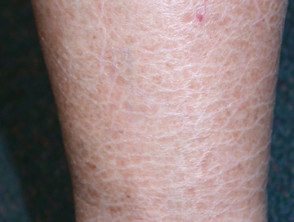
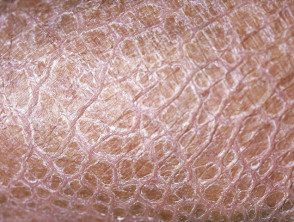
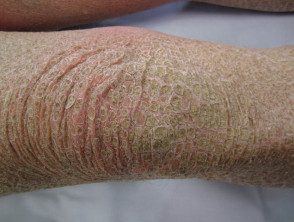
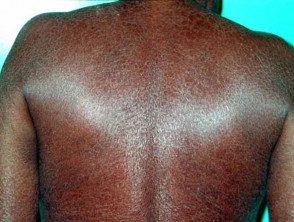
Kava ichthyosis
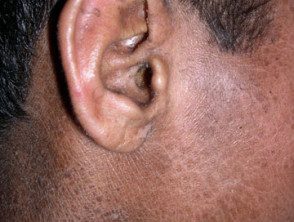
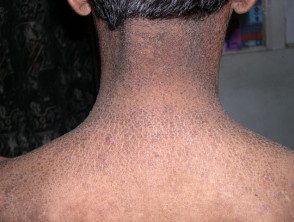

vulgar ichthyosis
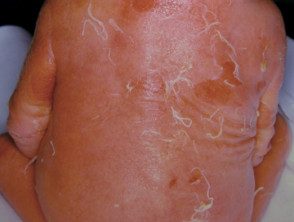
Epidermolytic ichthyosis
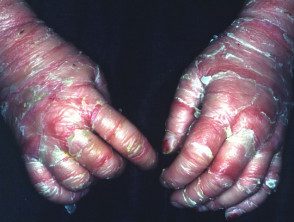
Epidermolytic ichthyosis

Acquired ichthyosis
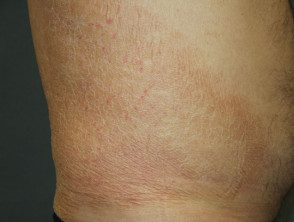
Acquired ichthyosis
See more images of ichthyosis.
Ichthyosis syndromes
Ichthyosis is a component of several rare congenital syndromes. These include:
- BOY GJB2, GJB6 (keratitis, ichthyosis and deafness)
- RING PORK (colobomas of the eye, heart defects, ichthyosis, mental retardation and hearing defects)
-
Netherton syndrome SPINK5 (ichthyosis, erythroderma, hair axis defects, atopic features)
-
Sjögren-Larsson ALDH3A2 (ichthyosis, spastic diplegia, pigmentary retinopathy, and mental retardation)
- Refsum disease PHYH / PEX7 (ichthyosis and pigmentary retinopathy).
How is ichthyosis diagnosed?
Ichthyosis is usually a clinical diagnosis. Genetic testing is available at some centers and prenatal Tests may be available for X-linked ichthyosis.
X-linked recessive ichthyosis is confirmed by the absence of steroid sulfatase in fibroblasts and elevated plasma cholesterol Sulfate levels.
Biopsy reveals:
- Thick, hyperkeratotic stratum corneum
- Reduced or absent granular cell layer and filaggrin in ichthyosis vulgaris
- 'Ghosts' of the lamellar body in lamellar ichthyosis
- Vacuolar degeneration of suprabasal keratinocytes and thick keratohyalin granules in a thickened granular layer in keratinopathic ichthyosis
What problems does ichthyosis cause?
People with very severe ichthyosis may need to spend several hours each day caring for their skin. Problems they encounter may include:
- Overheating: ichthyosis can affect normal temperature control reducing the ability to sweat
- Limited movement: dry, scaly the skin can make it too painful to move parts of the body
-
Secondary bacterial infection - cracking and splitting of the skin can lead to a skin infection and sometimes a systemic infection
- Hearing or Vision Impairment - Skin can build up over ears or eyes.
What is the treatment for ichthyosis?
There is no cure for inherited forms of ichthyosis. The following may be helpful.
- Soap-free cleaners (soap can exacerbate dryness)
- Bathing in salt water
- Rub with a pumice stone or exfoliating sponge to remove scales
-
Moisturizing creams that contain urea, salicylic acid, or alpha hydroxy acids. These are best applied to damp skin.
- In severe disease, the oral retinoids acitretin and isotretinoin
-
Oral antibiotics for secondary bacterial infection.
-
Vitamin D supplements for patients with severe forms of ichthyosis
Studies are underway to evaluate the effect of monoclonal antibodies targeting Th17 immune pathways.
What is the prognosis for ichthyosis?
The more severe forms of ichthyosis can be life-threatening in an affected newborn, but most people with ichthyosis have a normal life expectancy.
Inherited forms of ichthyosis persist throughout life.
Acquired ichthyosis can be resolved if the underlying cause can be effectively treated or if causal drug disrupted.

